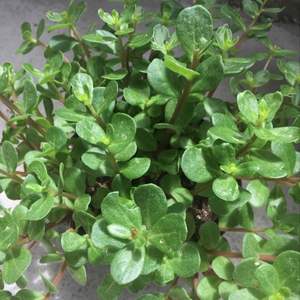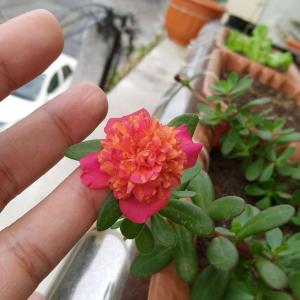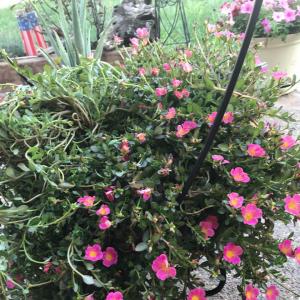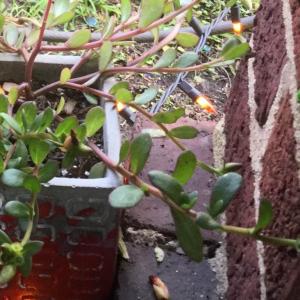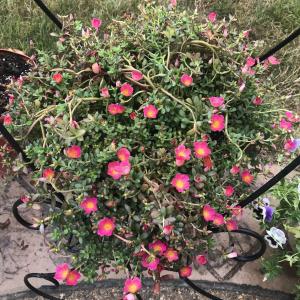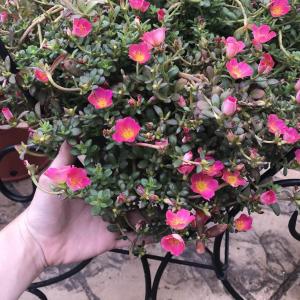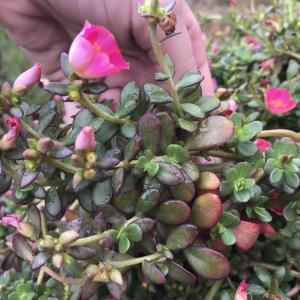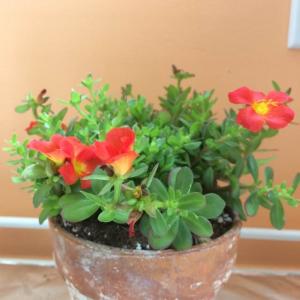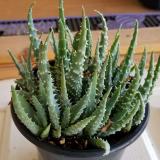文章
Miss Chen
2018年08月29日

Purslane, scientific name Portulaca oleracea, is an annual, edible succulent plant. It is also called Pusley, Verdolaga, Pigweed, and Hogweed.

Description
Purslane has a thick reddish stem and succulent, rounded leaves that grow in clusters. Its flowers are small and yellow, with five petals, and they bloom according to rainfall or moisture. It grows low to the ground and tends to spread.
Origin
Purslane originated in North Africa, the Middle East, and India. It probably spread to North America and elsewhere prior to the mid-1400s.
Cultivation
Purslane is an easy plant to grow, even in an arid climate. As a succulent, it is heat- and drought-tolerant, and a very hardy plant. In fact, it is often considered a weed in North America. It tends to sprawl across the ground, and will need to be cut back to be maintained.
Check with regulations in your area before planting purslane; in some regions it is considered an invasive weed.
Culinary Uses
All parts of Purslane are edible: leaves, flowers, and stem. It has a slightly sweet and sour flavor and a chewy texture. It is commonly eaten fresh, cooked, or in soups and stews.
Interesting Facts
Purslane is sometimes known as the Dolly Parton flower because of when it blooms--from 9 a.m. to 5 p.m.

Purslane is a good source of Omega-3 fatty acids and Vitamins A and C.
It is considered a edible plant in Mexican, Russian, and Mediterranean cultures, among others.

Description
Purslane has a thick reddish stem and succulent, rounded leaves that grow in clusters. Its flowers are small and yellow, with five petals, and they bloom according to rainfall or moisture. It grows low to the ground and tends to spread.
Origin
Purslane originated in North Africa, the Middle East, and India. It probably spread to North America and elsewhere prior to the mid-1400s.
Cultivation
Purslane is an easy plant to grow, even in an arid climate. As a succulent, it is heat- and drought-tolerant, and a very hardy plant. In fact, it is often considered a weed in North America. It tends to sprawl across the ground, and will need to be cut back to be maintained.
Check with regulations in your area before planting purslane; in some regions it is considered an invasive weed.
Culinary Uses
All parts of Purslane are edible: leaves, flowers, and stem. It has a slightly sweet and sour flavor and a chewy texture. It is commonly eaten fresh, cooked, or in soups and stews.
Interesting Facts
Purslane is sometimes known as the Dolly Parton flower because of when it blooms--from 9 a.m. to 5 p.m.

Purslane is a good source of Omega-3 fatty acids and Vitamins A and C.
It is considered a edible plant in Mexican, Russian, and Mediterranean cultures, among others.
0
0
求助
Tobyadams
2017年11月26日

Can anyone confirm this is purslane?? No white liquid when i break it
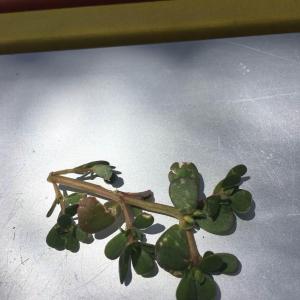

0
0
萌萌的南瓜:I 'm not good at English and hope you can understand what I said.🌸😁
萌萌的南瓜:Just an ordinary portulaca which has smooth stems and leaves .What's more,it also couldn't bloom flowers.Don't worry about it.
Ueca:This is purslane.
The poisonous one, Euphorbia vermiculata, has fuzzy stems and slightly serrated leaves.
文章
Dummer. ゛☀
2017年09月20日

Portulaca is a genus of the flowering plant family Portulacaceae, comprising about 40-100 species found in the tropics and warm temperate regions. They are also known as Purslane, Sun Plant, Rose Moss and Wax Pink. Common Purslane (P. oleracea) is widely considered an edible plant, and in some areas an invasive type of weed. Purslane can be eaten raw or cooked, and lends itself to stir fry dishes.
Members of the Portulaca genus are relatively easy to grow hardy or half hardy annuals that reach from 6 to 18 inches (15 to 45 cm) in height. They carry succulent leaves and bloom from summer to the second half of autumn and carry cup shaped flowers; these may be of yellow, red, pink or white.

Growing Conditions
Light: Full sunlight
Water: During the growing period the plants need frequent watering, but let dry between watering. Portulaca does not like wet conditions and will rot in constantly wet soil.
Soil: Well-drained soil is the best.
Fertilizer: An application of a balanced slow release fertilize with minor elements every 6 months.

General Care
Portulaca plants tolerate many kinds of soil but prefer sandy, well-drained soil and love the full sunlight. These plants are excellent for high heat and drought tolerance, and will seed and spread themselves very well. Some control methods may be needed to keep Portulaca plants from becoming invasive to areas where they are not wanted. These wonderful plants do spread easily and very well. Portulaca species such as Purslane require no attention at all when growing and flowering; however you should remove them from the garden before Portulaca have chance to set seed as they may take over the garden. You do not need to water often for proper Portulaca care. The cylindrical foliage of the Portulaca plants retains moisture very well, thus, regular watering is not needed. When they are watered, just a light watering will do, as their root zone is very shallow.
The seeds of Purslane and other Portulaca members should be sown on the soil surface following the last frost of spring. Ideally Purslane should be grown in a sunny part of the garden and Portulaca genus members thrive in hot areas. The soil that Purslane grows in should be sandy and poor with a pH of 5.5 to 7.

If starting Purslane indoors then start about one and a half months in advance. You first need to imbibe Purslane seeds by placing within soil in a plastic bag and placing in the fridge for about 15 days. Once finished, place the soil /seeds in light and germinate at 70 to 86 degrees Fahrenheit (21 to 30 degrees Celsius). It typically takes about one to three weeks for Purslane seeds to germinate. Once ready transfer into the garden at from 6 to 24 inches (15 to 60 cm) apart (depending on the size of the Portulaca species). This should be done towards the end of spring.
Members of the Portulaca genus are relatively easy to grow hardy or half hardy annuals that reach from 6 to 18 inches (15 to 45 cm) in height. They carry succulent leaves and bloom from summer to the second half of autumn and carry cup shaped flowers; these may be of yellow, red, pink or white.

Growing Conditions
Light: Full sunlight
Water: During the growing period the plants need frequent watering, but let dry between watering. Portulaca does not like wet conditions and will rot in constantly wet soil.
Soil: Well-drained soil is the best.
Fertilizer: An application of a balanced slow release fertilize with minor elements every 6 months.

General Care
Portulaca plants tolerate many kinds of soil but prefer sandy, well-drained soil and love the full sunlight. These plants are excellent for high heat and drought tolerance, and will seed and spread themselves very well. Some control methods may be needed to keep Portulaca plants from becoming invasive to areas where they are not wanted. These wonderful plants do spread easily and very well. Portulaca species such as Purslane require no attention at all when growing and flowering; however you should remove them from the garden before Portulaca have chance to set seed as they may take over the garden. You do not need to water often for proper Portulaca care. The cylindrical foliage of the Portulaca plants retains moisture very well, thus, regular watering is not needed. When they are watered, just a light watering will do, as their root zone is very shallow.
The seeds of Purslane and other Portulaca members should be sown on the soil surface following the last frost of spring. Ideally Purslane should be grown in a sunny part of the garden and Portulaca genus members thrive in hot areas. The soil that Purslane grows in should be sandy and poor with a pH of 5.5 to 7.

If starting Purslane indoors then start about one and a half months in advance. You first need to imbibe Purslane seeds by placing within soil in a plastic bag and placing in the fridge for about 15 days. Once finished, place the soil /seeds in light and germinate at 70 to 86 degrees Fahrenheit (21 to 30 degrees Celsius). It typically takes about one to three weeks for Purslane seeds to germinate. Once ready transfer into the garden at from 6 to 24 inches (15 to 60 cm) apart (depending on the size of the Portulaca species). This should be done towards the end of spring.
0
0
文章
Dummer. ゛☀
2017年09月18日

Calandrinia is a plant genus that contains many species of purslane, including the redmaids. The genus was named for Jean Louis Calandrini, an 18th-century Swiss botanist. It includes around 150 species of annual herbs which bear colorful flowers in shades of red to purple and white. Plants of this genus are native to Australia, Chile, and western North America.

Calandrinia are half hardy perennials and annuals. As the perennials have a short life span they are usually grown as half hardy annuals in the garden. They are low growing, reaching heights of about 6 to 18 inches (15 to 45 cm) and bloom with hundreds of bright pink and purple flowers from middle to late summer. Names for Calandrinia include Rock Purslane, Parakeelya and Redmaids. They are ideal, ground cover and edging plants, they can also be used in rockeries. Plants are able to grow in very hot conditions.

Growing Conditions and General Care
Calandrinia plants are very easy to care for as they can tolerate prolonged dry periods. They do not like to much water, especially in the winter. Plants are able to grow as a short lived perennial in warm regions but should be grown as annuals elsewhere. Propagate by taking cuttings or allow plants to self seed in situ.
If you plan to grow outdoors from seed then Calandrinia species should be sown at a depth of 0.1 inch (3 mm) after the last frost of spring. If you prefer to start off Calandrinia as seeds indoors then they should be started off about eight weeks before they are due to be put out.

They should be grown at a temperature of 55 to 59°F (13 to 15°C), and take from one to two weeks to germinate. The seedlings of Calandrinia should be planted out with a spacing of about 8 inches (20 cm) following the last possible frost of spring into an area that receives plenty of sun, and into a gritty or sandy soil.

Calandrinia are half hardy perennials and annuals. As the perennials have a short life span they are usually grown as half hardy annuals in the garden. They are low growing, reaching heights of about 6 to 18 inches (15 to 45 cm) and bloom with hundreds of bright pink and purple flowers from middle to late summer. Names for Calandrinia include Rock Purslane, Parakeelya and Redmaids. They are ideal, ground cover and edging plants, they can also be used in rockeries. Plants are able to grow in very hot conditions.

Growing Conditions and General Care
Calandrinia plants are very easy to care for as they can tolerate prolonged dry periods. They do not like to much water, especially in the winter. Plants are able to grow as a short lived perennial in warm regions but should be grown as annuals elsewhere. Propagate by taking cuttings or allow plants to self seed in situ.
If you plan to grow outdoors from seed then Calandrinia species should be sown at a depth of 0.1 inch (3 mm) after the last frost of spring. If you prefer to start off Calandrinia as seeds indoors then they should be started off about eight weeks before they are due to be put out.

They should be grown at a temperature of 55 to 59°F (13 to 15°C), and take from one to two weeks to germinate. The seedlings of Calandrinia should be planted out with a spacing of about 8 inches (20 cm) following the last possible frost of spring into an area that receives plenty of sun, and into a gritty or sandy soil.
0
0
文章
Dummer. ゛☀
2017年08月26日

Purslane herb is often considered to be a weed in many gardens, but if you get to know this fast-growing, succulent plant, you’ll discover that it is both edible and delicious. Growing purslane in the garden can be beneficial for your health and taste buds.
What is Purslane?
Purslane (Portulaca oleracea) is an herb that is native to Asia, but has spread all across the world. It is commonly found in cleared areas. The purslane herb has red stems and fleshy, green leaves. The flowers are a bright yellow. Purslane is high in Omega-3 fatty acids and contains vitamin A, vitamin C, vitamin B, magnesium, calcium, potassium and iron. All in all, edible purslane is a very healthy plant to add to your diet.
Growing Purslane
The hardest part about growing purslane is finding it. Once you have decided to grow purslane, you may find that although you have been pulling it out of your flower beds for years, it has suddenly disappeared. Once you do find a purslane plant, you can either harvest some seeds or trim off a few stems. All purslane needs to grow is part to full sun and clear ground. The plants aren’t picky about soil type or nutrition, but purslane does tend to grow better in drier soil. If you decide to plant purslane seeds, simply scatter the seeds over the area where you plan on growing the purslane. Don’t cover the seeds with soil. Purslane seeds need light to germinate so they must stay on the surface of the soil. If you are using purslane cuttings, lay them on the ground where you plan on growing purslane. Water the stems and they should take root in the soil in a few days.
Care of Purslane Plant
The care of purslane is very simple after it starts growing. You don’t need to do anything. The same traits that make it a weed also makes it an easy to care for herb. Make sure to harvest it regularly and be aware that it can become invasive. Harvesting before it develops flowers will help cut down on its spread. Also, keep in mind that purslane herb is an annual. While the chances are high that it will reseed itself, you may want to collect some seeds at the end of the season so that you have some on hand for next year, rather than hunting for a new purslane plant. If you decide to harvest wild purslane instead of growing purslane, make sure that you only harvest purslane that has not been treated with pesticides or herbicides.

What is Purslane?
Purslane (Portulaca oleracea) is an herb that is native to Asia, but has spread all across the world. It is commonly found in cleared areas. The purslane herb has red stems and fleshy, green leaves. The flowers are a bright yellow. Purslane is high in Omega-3 fatty acids and contains vitamin A, vitamin C, vitamin B, magnesium, calcium, potassium and iron. All in all, edible purslane is a very healthy plant to add to your diet.

Growing Purslane
The hardest part about growing purslane is finding it. Once you have decided to grow purslane, you may find that although you have been pulling it out of your flower beds for years, it has suddenly disappeared. Once you do find a purslane plant, you can either harvest some seeds or trim off a few stems. All purslane needs to grow is part to full sun and clear ground. The plants aren’t picky about soil type or nutrition, but purslane does tend to grow better in drier soil. If you decide to plant purslane seeds, simply scatter the seeds over the area where you plan on growing the purslane. Don’t cover the seeds with soil. Purslane seeds need light to germinate so they must stay on the surface of the soil. If you are using purslane cuttings, lay them on the ground where you plan on growing purslane. Water the stems and they should take root in the soil in a few days.

Care of Purslane Plant
The care of purslane is very simple after it starts growing. You don’t need to do anything. The same traits that make it a weed also makes it an easy to care for herb. Make sure to harvest it regularly and be aware that it can become invasive. Harvesting before it develops flowers will help cut down on its spread. Also, keep in mind that purslane herb is an annual. While the chances are high that it will reseed itself, you may want to collect some seeds at the end of the season so that you have some on hand for next year, rather than hunting for a new purslane plant. If you decide to harvest wild purslane instead of growing purslane, make sure that you only harvest purslane that has not been treated with pesticides or herbicides.
1
1
文章
Miss Chen
2017年08月14日

Portulaca is a large-flowered variety of purslane. It adds annual color to the flower garden, blooming from early summer until the first fall frost. Flowering may decline at midseason if portulaca isn't regularly deadheaded. Seed production uses up energy in the plant, so that there are no resources available for flowering. Removing the old flowers before they have a chance to form seeds, called deadheading, encourages the portulaca to continue producing its colorful and showy blossoms.

Step 1
Inspect portulaca plants in the morning for spent blooms. Flowers close in late afternoon and overnight, so flowers may appear spent at these times when they are not. All active flowers are open in the morning.
Step 2
Pinch off the withered blossoms. Remove the blossoms and the top ¼ inch of stem, so that the entire seed producing structure is removed from the plant.

Step 3
Cut out any dead or damaged stems or leaves completely. Remove these at the base of the plant.
Step 4
Dispose of or compost the removed flowers and leaves. Old plant matter left in the bed may provide bedding for insects or disease organisms.

Step 1
Inspect portulaca plants in the morning for spent blooms. Flowers close in late afternoon and overnight, so flowers may appear spent at these times when they are not. All active flowers are open in the morning.
Step 2
Pinch off the withered blossoms. Remove the blossoms and the top ¼ inch of stem, so that the entire seed producing structure is removed from the plant.

Step 3
Cut out any dead or damaged stems or leaves completely. Remove these at the base of the plant.
Step 4
Dispose of or compost the removed flowers and leaves. Old plant matter left in the bed may provide bedding for insects or disease organisms.
0
1
sarajordan2993
2017年07月22日

just took this picture of my #purslane (12:35am) - shes all closed up & sleeping . #succulent #weed
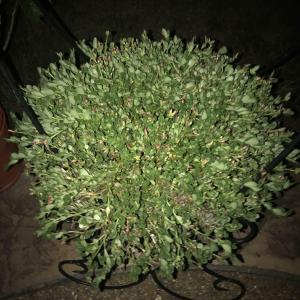
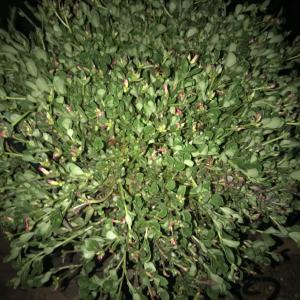


0
0



